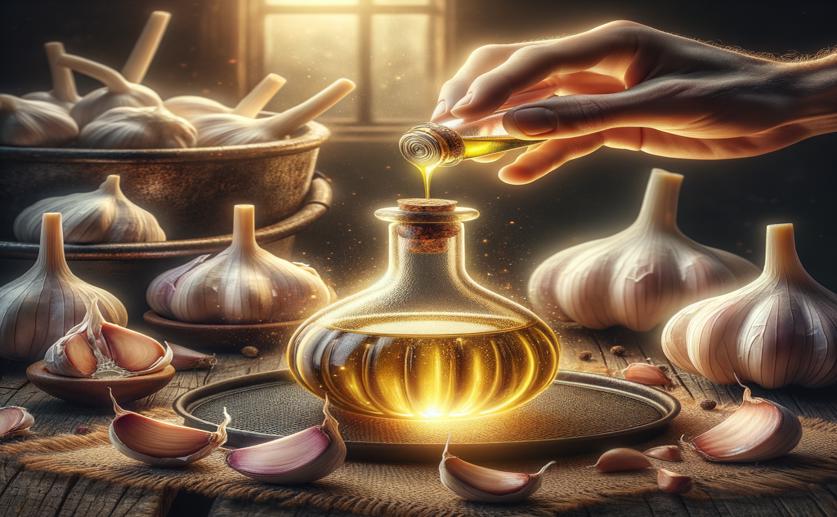Unlocking the Power of Garlic Oil: Fighting Bacteria and Boosting Health

Image Source: Natural Science News, 2024
Key Findings
- The study from Siksha 'O' Anusandhan University found that Indian Garlic Essential Oil (GEO) has strong antibacterial properties against eleven bacterial strains, including drug-resistant ones
- GEO's main component, Diallyl trisulphide (DTS), makes up 38% of its content and significantly contributes to its antimicrobial effects
- GEO disrupts bacterial cell membranes, leading to the release of harmful substances inside the bacteria, which is crucial for fighting multidrug-resistant pathogens
Garlic (Allium sativum L.), particularly its essential oil, has long been celebrated for its medicinal properties. A recent study conducted by Siksha 'O' Anusandhan (Deemed to Be University) evaluated the antimicrobial and antibiofilm efficacy of Indian Garlic Essential Oil (GEO) and its bioactive constituents[1]. This study is particularly pertinent given the increasing prevalence of drug-resistant bacterial strains, which pose significant challenges to public health.
The study identified allyl sulfur-rich compounds as the predominant phytochemicals in GEO, with Diallyl trisulphide (DTS) being the most abundant at 38%, constituting 96.51% of the total volatile oils. The researchers tested GEO against eleven bacterial strains, including three drug-resistant strains, and found significant antibacterial activity with minimum inhibitory concentrations (MICs) ranging from 78 to 1250 µg/mL. GEO effectively inhibited the growth of all tested strains at half of its MIC in bacterial growth kinetic assays. Additionally, GEO demonstrated strong antibiofilm activity against two key human pathogens, Staphylococcus aureus and Pseudomonas aeruginosa.
The mechanism behind GEO's antimicrobial action involves the disruption of bacterial cell membranes, leading to the release of nucleic acids, proteins, and reactive oxygen species. This mode of action is particularly important given the high incidence of multidrug-resistant (MDR) and extensively drug-resistant (XDR) bacteria, such as those classified under the ESKAPE group, which includes S. aureus and P. aeruginosa[2][3]. These pathogens are notorious for their ability to cause severe infections and their resistance to multiple antibiotics, making alternative treatments like GEO crucial.
The study also highlighted GEO's potent antioxidant activity, with an IC50 value of 31.18 mg/mL. Isolated constituents of GEO, such as Diallyl disulphide (DDS) and Diallyl trisulphide (DTS), showed effective antibacterial activity with MICs ranging from 125 to 500 µg/mL and 250 to 1000 µg/mL, respectively. This suggests that the individual components of GEO also contribute significantly to its overall antimicrobial properties.
The findings of this study are particularly relevant in the context of tuberculosis (TB) and other infectious diseases. Approximately one-third of the global population is latently infected with Mycobacterium tuberculosis (M.tb), the pathogen responsible for TB[4]. The evolution of antibiotic-resistant M.tb strains has re-escalated the death rate of TB, highlighting the urgent need for new anti-tubercular drugs. Traditional medicinal practices have long used various plants, including garlic, for treating TB and TB-like symptoms. The antimicrobial and immunomodulatory properties of bioactive compounds in these plants have been validated through modern scientific approaches[4].
The promising results of the GEO study suggest potential applications not only in the food industry but also in the medical field as an alternative or adjunct therapy for managing bacterial infections, including those caused by drug-resistant strains. The study underscores the importance of exploring traditional medicinal plants and their bioactive compounds to develop novel therapeutics for combating MDR pathogens.
In conclusion, the research conducted by Siksha 'O' Anusandhan (Deemed to Be University) provides compelling evidence for the antimicrobial and antibiofilm efficacy of Indian Garlic Essential Oil. By disrupting bacterial cell membranes and exhibiting strong antioxidant properties, GEO and its constituents offer a promising alternative for treating infections caused by drug-resistant bacteria, including those within the ESKAPE group. This study not only builds on the traditional use of garlic in medicine but also aligns with the urgent need for new treatments in the face of rising antimicrobial resistance.
MedicineBiochemSpices
References
Main Study
1) Deciphering the Antibiofilm, Antibacterial, and Antioxidant Potential of Essential Oil from Indian Garlic and its Phytocompounds Against Foodborne Pathogens.
Published 28th June, 2024
Journal: Current microbiology
Issue: Vol 81, Issue 8, Jun 2024
Related Studies
4) Potent anti-mycobacterial and immunomodulatory activity of some bioactive molecules of Indian ethnomedicinal plants that have the potential to enter in TB management.
https://doi.org/10.1111/jam.15088
Related Articles





 25th March, 2024 | Jenn Hoskins
25th March, 2024 | Jenn Hoskins